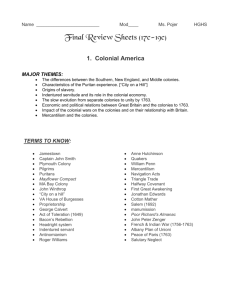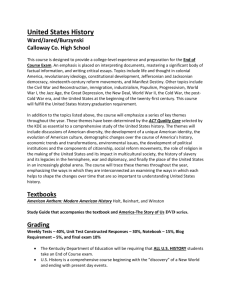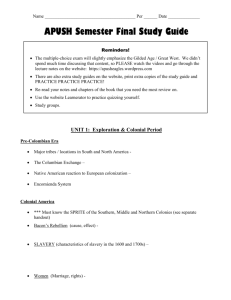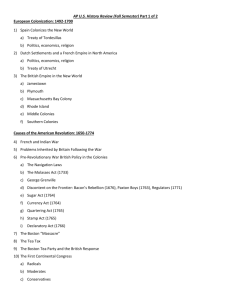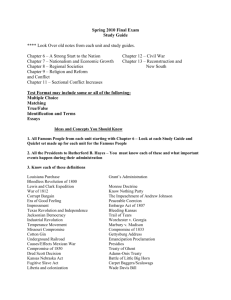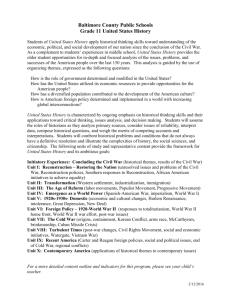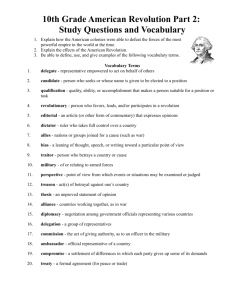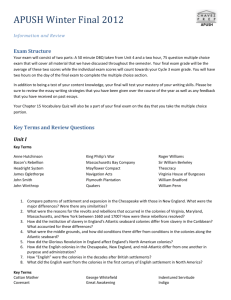1 - Miss Cummings' Social Studies Homepage
advertisement
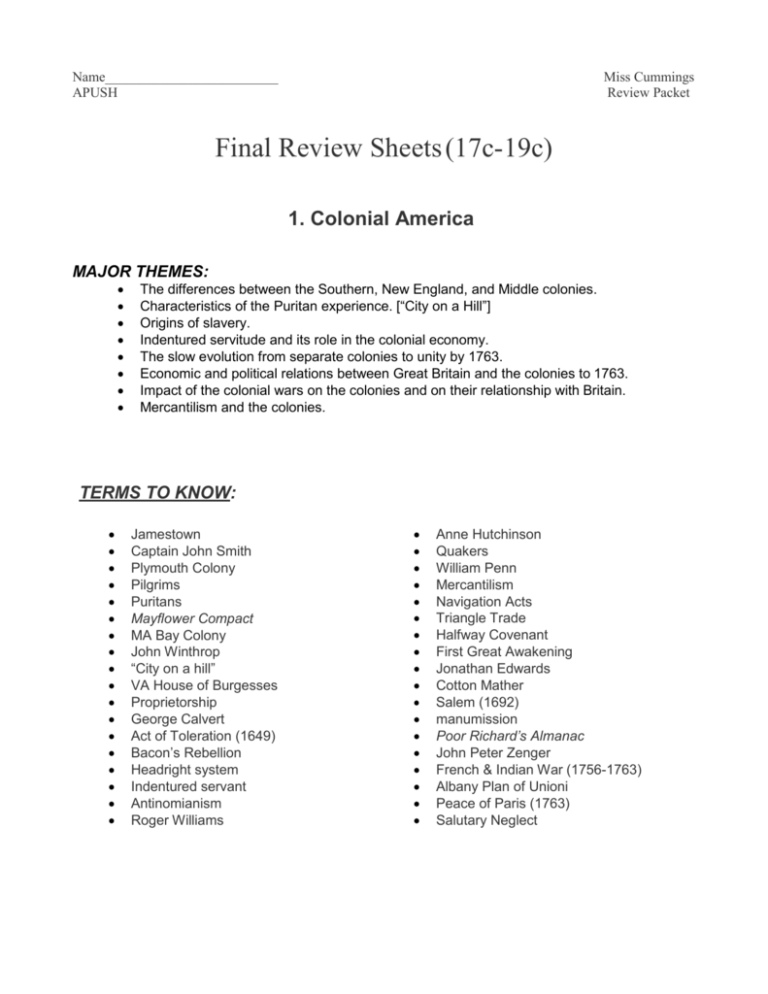
Name_________________________ APUSH Miss Cummings Review Packet Final Review Sheets (17c-19c) 1. Colonial America MAJOR THEMES: The differences between the Southern, New England, and Middle colonies. Characteristics of the Puritan experience. [“City on a Hill”] Origins of slavery. Indentured servitude and its role in the colonial economy. The slow evolution from separate colonies to unity by 1763. Economic and political relations between Great Britain and the colonies to 1763. Impact of the colonial wars on the colonies and on their relationship with Britain. Mercantilism and the colonies. TERMS TO KNOW: Jamestown Captain John Smith Plymouth Colony Pilgrims Puritans Mayflower Compact MA Bay Colony John Winthrop “City on a hill” VA House of Burgesses Proprietorship George Calvert Act of Toleration (1649) Bacon’s Rebellion Headright system Indentured servant Antinomianism Roger Williams Anne Hutchinson Quakers William Penn Mercantilism Navigation Acts Triangle Trade Halfway Covenant First Great Awakening Jonathan Edwards Cotton Mather Salem (1692) manumission Poor Richard’s Almanac John Peter Zenger French & Indian War (1756-1763) Albany Plan of Unioni Peace of Paris (1763) Salutary Neglect 1. Revolutionary America MAJOR THEMES: The short- and long-term causes of the American Revolution. Colonial assemblies as leaders against Great Britain. The Revolution was fomented by changes in British colonial policy in the 1763-1776 period. The Revolution was brought on by tight economic controls and loose political controls. The ideas/ideals expressed in the Declaration of Independence. Several different interpretations by historians on the causes of the American Revolution. Was the Treaty of Paris (1783) a victory for the U. S.? How had the 13 separate colonies become similar by the time of the Revolution? The American Revolution as a democratic revolution turned into an aristocratic government by the Constitution. The American Revolution as a question of home rule and who should rule at home. The American Revolution as a revolutionary event --> consider the economic and social changes associated with the Revolution. Was the Revolution avoidable? TERMS TO KNOW: Proclamation of 1763 Sugar Act (1764) Virtual representation Stamp Act (1765) Quartering Act (1765) Virginia Resolves Stamp Act Congress Sons of Liberty Writs of assistance Declaratory Act (1766) Townshend Acts (1767) Sam Adams Boston Massacre (1770) Patrick Henry John Dickinson Crispus Attucks Committees of Correspondence Boston Tea Party (1773) Intolerable [Coercive] Acts (1774) Quebec Act (1774) First Continental Congress (1774) Articles of Confederation Second Continental Congress (1775) Common Sense Lexington & Concord Olive Branch Petition Saratoga French Alliance of 1778 Loyalists (Tories) Yorktown (1781) Treaty of Paris (1783) Shay’s Rebellion Annapolis Convention Northwest Ordinance of 1787 2. The Constitution & Early Republic MAJOR THEMES: Enlightenment concepts and the Constitution. How critical was the “Critical Period”? Compare and contrast the Declaration of Independence, the Articles of Confederation, and the Constitution. Origins of the ideas of separation of powers, written constitutions, and federalism. Areas of agreement at the Constitutional Convention. Bill of Rights: provisions and meanings. Slavery and the Constitution. Failures of the Constitution led to the evolution of political parties. Liberty versus law and order in the 1790s. Hamilton’s economic program. Thomas Jefferson versus Alexander Hamilton. Differences between the Democratic-Republicans and the Federalists. Compare 1763-1776 with 1783-1800 in regard to the relationship between the central government and the colonies or states. Significance of these election years: 1796 & 1800. The “Revolution” of 1800. Loose versus strict construction as a matter of sectional or political interest. The significance of George Washington’s “Farewell Address”. TERMS TO KNOW: Philadelphia Convention (1787) James Madison Alexander Hamilton Virginia Plan New Jersey Plan Connecticut Plan 3/5s Compromise Federalists Anti-Federalists Strict constructionist Loose constructionist Federalist Papers (esp. #10) Judiciary Act (1789) Report on Public Credit (1790) Report on Manufactures (1791) “Citizen” Genet Jay Treaty (1794) Whiskey Rebellion (1794) Washington’s “Farewell Address” (1796) Democratic-Republican Party XYZ Affair Alien & Sedition Acts (1798) KY & VA Resolutions (1799) Revolution of 1800 3. Jeffersonian Age 1800-1824 (Jefferson, Madison, Monroe) MAJOR THEMES: Decline and death of the Federalist Party. “Era of Good Feeling”. Marshall and his Supreme Court decisions. What caused Jeffersonian Democracy to develop? Compare the Second Party System with the First. Rise and development of political parties --> economic, social, and geographical characteristics and leaders. Hamilton’s economic program created the political issues for the next 50 years. The positions, rationale, issues, and spokesmen for the sections on the following political topics: tariff, banking, internal improvements, expansion, and slavery. The significance of the 1824 election. The War of 1812 as a second War for Independence. Foreign policy united and divided Americans between 1800 and 1824. The interests of the West were satisfied by neither the Jeffersonians nor the Federalists between 1789 and 1815. Provisions and impact of the Monroe Doctrine. Clay’s “American System”. TERMS TO KNOW: Louisiana Purchase Lewis & Clark Judiciary Act (1801) “Midnight Judges” Judicial review John Marshall Marbury v. Madison (1803) Fletcher v. Peck (1810) McCulloch v. Maryland (1819) Dartmouth College v. Woodward (1819) Cohens v. Virginia (1821) Gibbons v. Ogden (1824) Aaron Burr Embargo Act (1807) Macon’s Bill #2 (1810) War Hawks John C. Calhoun (SC) Henry Clay (KY) War of 1812 Impressment Hartford Convention (1814) Treaty of Ghent (1814) Battle of New Orleans “Era of Good Feeling” Tariff of 1816 Rush-Bagot Agreement (1817) Adams-Onis Treaty (1819) Panic of 1819 Missouri Compromise of 1820 Monroe Doctrine (1823) Erie Canal Robert Fulton Eli Whitney Samuel Slater Lowell System Denmark Vessey (1822) 4. The Age of Jackson: 1824-1840 (John Q. Adams, Jackson, Van Buren) MAJOR THEMES: What caused Jacksonian Democracy to develop? Immediate and long range consequences of the split between Jackson and Calhoun. Significant elections: 1828, 1832, and 1840. An era of the common man? Sectional tensions: 1800-1840 --> what were the issues? TERMS TO KNOW: “Corrupt Bargain” Tariff of Abomination (1828) “Age of the Common Man” “King Andrew” spoils system Peggy Eaton Affair Indian Removal Act (1830) Cherokee Nation v. Georgia (1831) Worcester v. Georgia (1832) “Trail of Tears” nullification Tariff of Abomination Webster-Hayne Debate Proclamation to the People of SC Second Bank of the U. S. Nicholas Biddle Two-Party System “pet banks” Roger Taney Specie Circular “Log Cabin & Cider” campaign “peculiar institution” Nat Turner Panic of 1837 5. Antebellum Reform MAJOR THEMES: Transcendentalism: why, what was it, leaders. Reform characterized by perfectionism, distrust of established institutions, and uncompromising impatience. Hudson River School of Painting and a unique American culture [art, literature, education] Compare the First and Second Great Awakenings. Strengths and weaknesses of democracy as illustrated by abolitionism and the women’s movement. TERMS TO KNOW: Second Great Awakening Mormons Joseph Smith Brigham Young Romanticism Transcendentalism Ralph Waldo Emerson Henry David Thoreau Brook Farm Shakers Oneida Community Joseph Henry Noyes Thomas Cole Frederick Church Hudson River School Washington Irving James Fennimore Cooper Nathanial Hawthorne Temperance Dorothea Dix Horace Mann McGuffey Reader Grimke Sisters Lucretia Mott Elizabeth Cady Stanton Seneca Falls Convention (1848) Susan B. Anthony William Lloyd Garrison The Liberator Frederick Douglass Harriet Tubman Sojourner Truth David Walker Amelia Bloomer 6. 1830s-1860: Westward Expansion & Sectionalism (William H. Harrison, John Tyler, James K. Polk, Zachary Taylor, Millard Fillmore, Franklin Pierce, James Buchanan) MAJOR THEMES: Principles that caused territorial expansion between 1815 and 1860. Trace sectionalism from 1810-1850 through the careers of Clay, Calhoun, and Webster. Manifest Destiny and the road to war. Impact of Manifest Destiny on both foreign affairs and domestic politics. Why was Oregon annexed peacefully, but not Texas? TERMS TO KNOW: Whigs Manifest Destiny Stephen Austin Sam Houston Santa Ana Webster-Ashburton Treaty (1842) Gold Rush Samuel F. B. Morse Compromise of 1850 Fugitive Slave Law Underground Railroad Harriet Beecher Stowe Hinton R. Helper George Fitzhugh Kansas-Nebraska Act (1854) Know-Nothings Commodore Matthew Perry (1853) 54o 40’ Or Fight! Mexican War (1846-1848) John C. Fremont Treaty of Guadelupe-Hidalgo (1848) Wilmot Proviso Free Soilers Clayton-Bulwer Treaty (1850) Gadsden Purchase (1853) Popular sovereignty “Bleeding Kansas” John Brown Harper’s Ferry, VA Sumner-Brooks Dred Scott v. Sanford (1857) Lincoln-Douglas Debates (1858) A House Divided Freeport Doctrine Crittenden Compromise (1860) 7. Civil War & Reconstruction (Lincoln, Andrew Johnson, Grant, Hayes) MAJOR THEMES: Slavery from the viewpoint of the slave, the slaveholder, and the non-slaveholding white Southerner. The issue of slavery in the territories. Slavery as a threat to white Northern labor. Compare the black struggle to achieve freedom with the abolitionist struggle to free slaves. Blacks in the North: 1790-1860. William Lloyd Garrison-->hero or villain of the antislavery movement. The Civil War began with the Mexican War!? Northerners objected not to slaves but to the political and economic power and influence slavery gave the slaveholder in the national government. Event, person, or place as a symbol of North-South division, such as Bleeding Kansas, John Brown, or the Crittenden Compromise. Southern grievances against the North. North-South economic differences before the Civil War that continued unresolved after it. The 1850s-->a decade of political sectionalism and economic nationalism. Role of the Supreme Court in the Civil War and Reconstruction. Breakdown of both the Whig and Democratic parties in the 1850s and rise of the third party system. Struggle between the president and Congress for dominant political power within the federal government, 1850-1868. States’ rights from 1790-1860 for all the sections. Civil Wartriumph of American democracy over European aristocracy (“slaveocracy”). When did the Civil War become inevitable and why? What causes of the Civil War were resolved by the Civil War and Reconstruction? Was the Republican Party consistent in its policies from the 1850s to 1877? The issues of the Civil War were similar to those of the American Revolution. Accomplishments and failures of Reconstruction. Compare the social and political gains made by Blacks during Reconstruction with those during the second Reconstruction, and during the 1950s and 1960s. Major developments in the history of Blacks between 1865 and 1912. TERMS TO KNOW: Fort Sumter Jefferson Davis Bull Run (I & II) Anaconda Plan George McClellan Antietam Merrimac & Monitor Gettysburg 13th Amendment Emancipation Proclamation (1863) Sherman’s “March to the Sea” Appomattox ex parte Merriman Copperheads Greenbacks Morrill Tariff Act (1861) Homestead Act (1862) Morrill Land Grant Act (1862) Ex Parte Milligan 10% Plan Presidential Reconstruction Wade-Davis Bill (1864) Sherman’s Field Order #15 Freedman’s Bureau Black Codes Radical (Congressional) Reconstruction Civil Rights Act (1866) 14th Amendment 15th Amendment Tenure of Office Act (1867) Scalawag Carpetbagger Crop lien system “Waving the Bloody Shirt” Credit Mobilier Panic of 1873 (“Crime of ‘73”) Redeemers KKK Compromise of 1877 8. Closing the Frontier & the New South MAJOR THEMES: Why was the Great Plains settled last? What brought a speedy end to the frontier? Economic and political consequences of the closing of the frontier. Theories of Frederick Jackson Turner--> The “myth” of the frontier in American culture and how did it influence American character? Evolution of federal land policy toward Indians to 1924. Farmers versus the railroads and industry. TERMS TO KNOW: Sand Creek Massacre (1864) Chinese Exclusion Act (1882) Frederick Jackson Turner George A. Custer Little Big Horn Chief Joseph Helen Hunt Jackson Plessy v. Ferguson (1896) Grandfather clause Ida B. Wells Booker T. Washington W. E. B. DuBois Granger Laws Munn v. Illinois (1876) Dawes Severalty Act (1887) Ghost Dance Wounded Knee, SD George Washington Carver Tuskegee Institute Jim Crow Civil Rights Cases of 1883 9. Interstate Commerce Act (1886) National Alliance Populism Ocala Platform Dear money Soft money Big Business, Big Labor, & Big Cities (Garfield, Arthur, Cleveland, Benjamin Harrison, Cleveland, McKinley) MAJOR THEMES: Compare and contrast the Democratic and Republican Parties: base of support, policies, successes, etc. Changes in the economy from 1865-1900 in transportation, agriculture, labor force, and industry. Rise of corporations, trusts, pools, and holding companies. Factors that promoted industrialization. Trace shifting Supreme Court decisions in regard to the regulation of railroads and industry. This period as one of governmental intervention in the economy, NOT of laissez-faire. The role and significance of technological innovations. The 1890s as a decade of economic, political, and social crises. Characteristics of different labor unions --> NLU, Knights of Labor, AFL, ARU—differences, successes, failures, leaders, reasons for directions they took. Changing workplace conditionswages, hours, safety. Compare and contrast the Haymarket Square riot, the Homestead strike, and the Pullman strike. Attitude of government, state and federal, toward labor unions to 1914. Explain the location and growth of the post-Civil War cities. Rise of speactator sports. Gilded Age as an era of “conspicuous consumption” [Thorstein Veblen’s phrase]. Reformers’ attempts to address problems of poverty, housing, and health. Municipal governments --> why were they so bad? Why so frustrating to reformers? Women’s Movement: 1848-1920. Churches’ attack on social and economic problems. The Social Gospel as a religious movement. Darwinism and church leaders. Reactions to immigration: pre-Civil War versus Civil War to 1920s. Urbanization reflected in art and literature. Compare and contrast Henry George and Edward Bellamy. Compare and contrast the treatment of immigrants, Blacks, and Indians during this postCivil War era. Southern whites reestablished political control after Reconstruction and modernized the Southern economy. Rise of Jim Crow laws. Booker T. Washington versus W. E. B. DuBois. Populism urged political solutions to economic problems. Why did Populism fail, or did it? Problems facing farmers. Compare and contrast the Grange, the Farmers’ Alliance, and Populism. Connect Southern Populism and the rise of racism. TERMS TO KNOW: Gilded Age Robber Barons Cornelius Vanderbilt Jay Gould Andrew Carnegie John D. Rockefeller Sherman Antitrust Act (1890) U. S. v. E. C. Knight (1890) Social Darwinism Gospel of Wealth Thomas A. Edison Horatio Alger Yellow-dog contract Open shop Closed shop Railroad Strike of 1877 Knights of Labor Haymarket Riot (1886) AFL Samuel Gompers Homestead Strike (1892) Pullman Strike (1894) In Re Debs Boss Tweed Thomas Nast Henry George Jacob Riis Edward Bellamy Settlement Movement Jane Addams Social Gospel Carry Nation Louis Sullivan Chicago School of Architecture William Lloyd Wright “Melting Pot” theory Emma Lazarus Pendleton Act (1885) Bland-Allison Act (1878) Sherman Silver Purchase Act (1890) Panic of 1893 Coxey’s Army William Jennings Bryan Mark Hanna “Cross of Gold” Silver bugs Gold bugs 10. America Imperialism (McKinley, Teddy Roosevelt, Taft, Wilson) MAJOR THEMES: Organize U. S. foreign policy from 1870-1920 by: (1) geographic region-->Far East, Latin America, Caribbean, Europe; (2) American motives-->economic, moral, Monroe Doctrine, balance of power among European nations, dominance in the Caribbean; (3) influence of domestic policies on foreign policy. Imperialism: characteristics, sources, nature, causes, impact, results, compared to European imperialism. Link-->Reconstruction, Populism, and Imperialism. Compare and contrast the old and the new Manifest Destiny. Roosevelt’s foreign policy. Wilson’s foreign policy. U. S. policy toward Mexico and Cuba, 1890s-1930s. TERMS TO KNOW: Treaty of Kanagawa “Seward’s Folly” Alfred Thayer Mahan Jingoism Yellow journalism William Randolph Hearst Spanish-American War (1898) De Lome Letter Remember the Maine, to Hell with Spain! Teller Amendment Rough Riders Queen Liliukalani Emilio Aguinaldo “White Man’s Burden” Anti-Imperialist League Insular cases Platt Amendment Open Door Policy Boxer Rebellion “Big Stick” policy Roosevelt Corollary Panama Canal Gentleman’s Agreement Treaty of Portsmouth (1905) “Dollar Diplomacy” Henry Cabot Lodge, Sr. Jones Act (1916) “Moral Diplomacy” Tampico Incident Pancho Villa John J. Pershing “Colossus of the North
